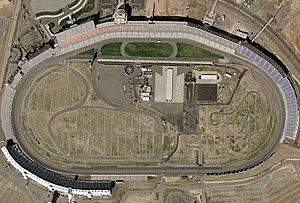
The Indianapolis 500, formally known as the Indianapolis 500-Mile Race, and commonly called the Indy 500, is an annual automobile race held at Indianapolis Motor Speedway (IMS) in Speedway, Indiana, United States, an enclave suburb of Indianapolis. The event is traditionally held over Memorial Day weekend, usually the last weekend of May. It is contested as part of the IndyCar Series, the top level of American open-wheel car racing, a formula colloquially known as "Indy car racing". The track itself is nicknamed the "Brickyard", as the racing surface was paved in brick in the fall of 1909. One yard of brick remains exposed at the start/finish line. The event, billed as The Greatest Spectacle in Racing, is considered part of the Triple Crown of Motorsport along with the 24 Hours of Le Mans and the Monaco Grand Prix, with which it typically shares a date.

Championship Auto Racing Teams (CART) was a sanctioning body for American open-wheel car racing that operated from 1979 until dissolving after the 2003 season. CART was founded in 1979 by United States Auto Club (USAC) Championship Division team owners who disagreed with the direction and leadership of USAC, with the then-novel idea of team owners sanctioning and promoting their own series collectively instead of relying on a neutral body to do so. Through the 1980s, CART's Indy Car World Series became the pre-eminent open-wheel auto racing series in North America, featuring street circuits, road courses, and oval track racing. CART teams continued to compete at the USAC-sanctioned Indianapolis 500, which was effectively integrated into the series schedule.

The Indianapolis Motor Speedway is a motor racing circuit located in Speedway, Indiana, an enclave suburb of Indianapolis, Indiana. It is the home of the Indianapolis 500 and the Brickyard 400 and formerly the home of the United States Grand Prix and Indianapolis motorcycle Grand Prix. It is located six miles (9.7 km) west of Downtown Indianapolis.

Michigan International Speedway (MIS) is a 2 mi (3.2 km) moderate-banked D-shaped speedway located in Cambridge Township, Michigan, approximately four miles south of the village of Brooklyn. Situated on more than 1,400 acres (5.7 km2) in the Irish Hills area of southeastern Michigan, the track is 70 miles west of the center of Detroit, 40 miles from Ann Arbor, and 60 miles (97 km) south and northwest of Lansing, Michigan and Toledo, Ohio, respectively. MIS is used primarily for NASCAR events. It is sometimes known as a sister track to Texas World Speedway, and was used as the basis of Auto Club Speedway. The track is owned by NASCAR. Michigan International Speedway is recognized as one of motorsports' premier facilities because of its wide racing surface and high banking.
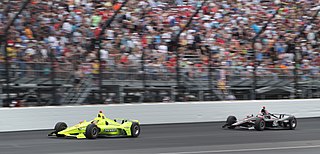
American open-wheel car racing, generally known as Indy car racing, or more formally Indianapolis car racing, is a category of professional automobile racing in the United States. As of 2024, the top-level American open-wheel racing championship is sanctioned by IndyCar. Competitive events for professional-level, open-wheel race cars have been conducted under the auspices of various sanctioning bodies, tracing its roots as far back as 1902. A season-long, points-based, National Championship of drivers has been officially recognized in 1905, 1916, and each year since 1920. As such, for many years, the category of racing was known as Championship car racing. That name has fallen from use, and the term Indy car racing has become the preferred moniker.
Gregory Ray is an American former race car driver.
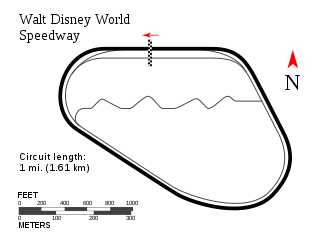
Walt Disney World Speedway was a racing facility located on the grounds of the Walt Disney World Resort in Bay Lake, Florida, near Orlando.
Team Menard was an auto racing team that competed in the Indianapolis 500, CART, Indy Racing League, NASCAR Cup Series, and NASCAR Craftsman Truck Series. The team was owned by Menards founder, John Menard Jr. Founded in 1980 to compete in CART, from 1991 to 1996 they modified their own Buick V6 engines for racing. This combination won pole for the 500 with Scott Brayton in 1995 and 1996; Tony Stewart used this combination for the first part of his 1996-1997 IRL Championship. With more stringent regulations, the team continued to shine winning the 1999 championship with Greg Ray. However, with the influx of former CART teams to the IRL in the early 2000s, Team Menard struggled to compete for wins and the team merged in 2004 with Panther Racing, although their car continued to carry Menard's colors and be driven first by Mark Taylor, who was then replaced by Townsend Bell. In 2005, Menard's was an associate sponsor for another team and the former Menard No. 2 car driven by Tomáš Enge carried no identification to its Menard lineage. For 2006, the No. 2 car was dropped by Panther and all vestiges of the once dominant Team Menard lineage disappeared until the spring of 2008 when Menards became a primary sponsor on the No. 20 Vision Racing Dallara driven by Ed Carpenter in the IndyCar Series.

The 1996–97 Indy Racing League was the second season contested by the Indy Racing League. Tony Stewart was the champion, while Arie Luyendyk won the Indianapolis 500. The lengthy season was a result of the league abandoning the concept of ending each season with the Indianapolis 500. The 1996–97 season would ultimately consist of the two races that followed the Indy 500 in the calendar year of 1996, and all events contested in the calendar year of 1997. It also saw the introduction of a new chassis and engine package.

The 1999 Pep Boys Indy Racing League was highly competitive and parity was the order of the year. Team Menard had a very good season with their driver Greg Ray capturing 3 race wins and the series championship. This was the last year before CART teams began to break ranks and jump to the IRL.

The 83rd Indianapolis 500 was held at the Indianapolis Motor Speedway in Speedway, Indiana, on Sunday, May 30, 1999. The race was sanctioned by the Indy Racing League, and was part of the 1999 Pep Boys Indy Racing League season. Defending IRL champion Kenny Bräck started 8th and became the first Swedish driver to win the Indy 500.
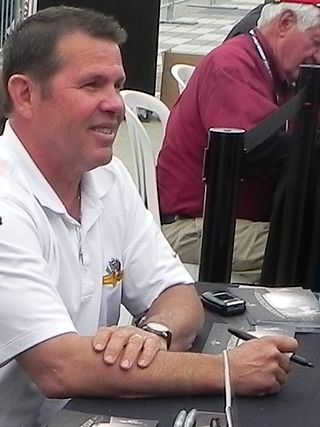
Donnie Beechler, is a former driver in the Indy Racing League. He was born in Springfield, Illinois.
Stan Wattles is a former driver in the Indy Racing League. He raced in the 1996–2001 seasons with 19 career starts, including the Indianapolis 500 in 1998–2000. He placed 8th in two races, and led his 2 laps in his first, in 1996 at Walt Disney World Speedway, but never led in his other contests. In the 1999 VisionAire 500K at Lowe's Motor Speedway, Wattles was involved in a crash that killed three spectators when debris from his car cleared the fence, and 18 laps later, the race was cancelled.

Andy Michner, is a former driver in the Indy Racing League IndyCar Series, NASCAR Craftsman Truck Series and NASCAR Busch Series. He is the current record holder of the world's fastest Sprint Car race at a United States Auto Club event in Phoenix, Arizona at 136.034 mph 1996. Michner finished twice a runner-up to NASCAR'S Tony Stewart in United States Auto Club competition and has 19 USAC Wins. He passed his Indy 500 Rookie Orientation Program but elected to not qualify for the race 1996 Indianapolis 500. In 1996 & 1997, Michner ran a partial season in the NASCAR Craftsman Truck Series as Chevrolet's Development Driver. He then returned to the Indy Car series in 1998 with Konica/Syan Racing and captured his career best finish of eighth place in his first race, the 1998 Indianapolis 500. Michner then signed with Factory Riley&Scott Reebok Indycar Team where Michner led in the closing laps of the 1998 Texas Longhorn 500 but failed to finish due to an engine failure. At Michigan International Speedway in August 1998, it was announced, Michner signed a 3-year contract to drive the Bayer Aleve, Coca-Cola Chevrolet in NASCAR's Busch Series for BACE Motorsports. Michner suffered ultimately career ending injuries in October 1998 while testing at Homestead-Miami Speedway in a NASCAR Busch Series test. He attempted to qualify for the 1999 Indianapolis 500 for Byrd Racing but failed to make the field due to rain. He was named to a Logan Racing entry to two races in 2000 but the car did not appear at either race.
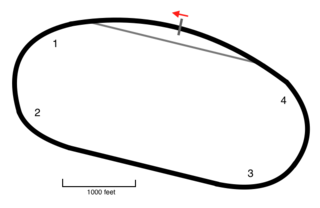
The Michigan 500 was an IndyCar Series race held at Michigan International Speedway in Brooklyn, Michigan. Held from 1981 to 2001, the event was held in high prestige, constituting part of Indy car racing's 500-mile "Triple Crown".

The IZOD IndyCar World Championship Presented by Honda was an IndyCar Series race on the 1.5-mile (2.4 km) Las Vegas Motor Speedway, held from 1996 to 2000, and again in 2011. It was first known as the Las Vegas 500k. The Champ Car World Series held a race at the track during the 2004 and 2005 seasons as doubleheaders with the NASCAR Camping World Truck Series and a street race was held in Las Vegas at the Fremont Street Experience in 2007.
Treadway Racing is a former auto racing team that competed in the early seasons of the Indy Racing League IndyCar Series. The team was owned by Indianapolis business man Fred Treadway. Prior to the IRL's inaugural season in 1996, Treadway was able to sign former Indianapolis 500 Champion Arie Luyendyk to drive for his freshman team. Additionally, two long time backers of IndyCar teams, Bryant Heating & Cooling Systems and Jonathan Byrd's Cafeteria, were secured as sponsors.

The 1996 Las Vegas 500K was the second round of the 1996-1997 Indy Racing League. The race was held on September 15, 1996, and was the inaugural event for the 1.500 mi (2.414 km) Las Vegas Motor Speedway in Clark County, Nevada. It was the fifth and last race for the IRL in the year 1996, and, thus, the last race contested under the frozen 1995 IndyCar regulations, before the arrival of a new chassis and engine formula for 1997. Richie Hearn was the winner of the race, which was defined by its multiple crashes and high attrition, with nine lengthy cautions, 83 laps under yellow, a red flag and four drivers being extricated from their cars.

The 1999 VisionAire 500K was a scheduled Indy Racing League event to be run in May 1, 1999 at Lowe’s Motor Speedway in Concord, North Carolina, USA. The race was to be the third race of the 1999 Indy Racing League schedule, after stops at Atlanta Motor Speedway and Phoenix International Raceway.
